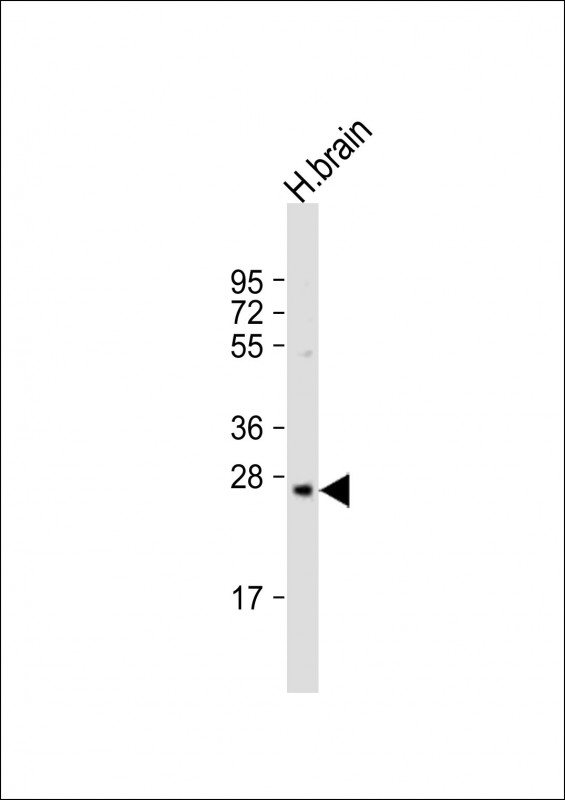
| WB | 1/2000 | Human,Mouse,Rat |
| IF | 咨询技术 | Human,Mouse,Rat |
| IHC | 咨询技术 | Human,Mouse,Rat |
| ICC | 技术咨询 | Human,Mouse,Rat |
| FCM | 咨询技术 | Human,Mouse,Rat |
| Elisa | 咨询技术 | Human,Mouse,Rat |
| Aliases | Serine protease 33, 3421-, Serine protease EOS, PRSS33 |
| Entrez GeneID | 260429 |
| WB Predicted band size | 29.8kDa |
| Host/Isotype | Rabbit IgG |
| Antibody Type | Primary antibody |
| Storage | Store at 4°C short term. Aliquot and store at -20°C long term. Avoid freeze/thaw cycles. |
| Species Reactivity | Human, Mouse, Rat |
| Immunogen | This PRSS33 antibody is generated from a rabbit immunized with a KLH conjugated synthetic peptide between 105-128 amino acids from the Central region of human PRSS33. |
+ +
以下是关于PRSS33抗体的3篇参考文献及其摘要概括:
---
1. **文献名称**: *PRSS33 expression in epidermal keratinocytes is involved in skin barrier homeostasis*
**作者**: Li W, et al.
**摘要**: 该研究利用特异性PRSS33抗体,揭示该丝氨酸蛋白酶在皮肤角质层形成中的作用,发现其通过调控角质细胞分化参与表皮屏障功能。
2. **文献名称**: *Protease-mediated activation of PRSS33 promotes tumor invasion in colorectal cancer*
**作者**: Zhang Y, et al.
**摘要**: 通过免疫组化(使用PRSS33抗体)和分子实验,证明PRSS33在结直肠癌中高表达,其活性与肿瘤细胞侵袭转移相关,提示其作为潜在治疗靶点。
3. **文献名称**: *PRSS33 regulates macrophage polarization via PAR2 signaling in inflammatory diseases*
**作者**: Kim H, et al.
**摘要**: 研究利用PRSS33中和抗体,发现该蛋白酶通过激活PAR2信号通路调控巨噬细胞M1/M2极化,影响炎症性疾病进程。
---
以上文献涵盖皮肤屏障、癌症及炎症领域,展示了PRSS33抗体的应用场景。如需具体文章链接或补充,可进一步提供研究方向。
**Background of PRSS33 Antibody**
PRSS33 (Protease Serine 33) is a member of the trypsin-like serine protease family, encoded by the *PRSS33* gene. This enzyme is primarily expressed in epithelial tissues, including the skin, gastrointestinal tract, and respiratory system, where it plays roles in maintaining barrier function and regulating cellular processes. PRSS33 is synthesized as an inactive zymogen and undergoes proteolytic cleavage to become enzymatically active. Its activity is implicated in the degradation of extracellular matrix components, cell adhesion, and immune modulation, potentially influencing inflammatory responses and tissue remodeling.
Antibodies targeting PRSS33 are critical tools for investigating its expression, localization, and function in both physiological and pathological contexts. Studies have linked PRSS33 to diseases such as atopic dermatitis, psoriasis, and cancer, where its dysregulation may contribute to pathogenesis. For example, elevated PRSS33 levels in certain cancers suggest a role in tumor progression via protease-mediated pathways.
PRSS33 antibodies are utilized in techniques like Western blotting, immunohistochemistry (IHC), and immunofluorescence (IF) to detect protein expression patterns in tissues or cell lines. They also aid in functional studies, such as blocking enzymatic activity to assess its biological impact. Commercial availability of PRSS33 antibodies, often validated for specificity and sensitivity, supports research into its mechanistic roles and potential as a therapeutic or diagnostic target. Ongoing research aims to clarify its interactions with substrates and signaling pathways, advancing understanding of epithelial biology and disease mechanisms.
×